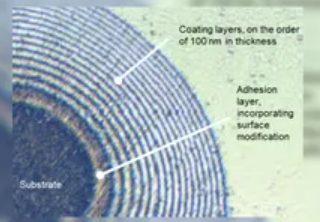Nanocomposite Coatings for Gears

Small reductions in friction can result in large savings in power requirements, particularly at high speed. Lowering the viscosity of lubricating oils helps, but there is a lower limit on lubricant viscosity where functionality in the application is retained. Nanocomposite thin-film coatings have been employed in various applications to reduce sliding friction and surface wear and are proposed for use in gear applications.
This work aims to demonstrate the potential benefit of applying nanocomposite coatings to gear teeth to reduce operating friction and wear by presenting tribological test data.
A brief history of thin film coating technology development history is given in the following paragraphs (Refs. 1, 2).
World War II Era
Optical Coatings: During World War II, the demand for improved optics led to advancements in optical coatings. Antireflective coatings, composed of thin films, were developed to enhance the performance of lenses and other optical devices.
Post-World War II
Thin-Film Deposition Techniques: In the post-war period, there was significant progress made in thin-film deposition techniques. Vacuum deposition methods emerged, such as Physical Vapor Deposition (PVD) and Chemical Vapor Deposition (CVD). These techniques enabled precise control over coating thickness, microstructure, and composition, laying the foundation for developing nanocomposite coatings.
1950s–1960s
Semiconductor Industry: The semiconductor industry’s growth in the 1950s and 1960s drove advancements in thin-film technology. Thin films became integral to the manufacturing of semiconductors, with techniques like sputtering and evaporation becoming widely adopted.
1970s–1980s
Plasma-Assisted Techniques: The use of plasmas to assist in thin-film deposition gained prominence in the 1970s and 1980s. Plasma-Assisted Chemical Vapor Deposition (PACVD) and Plasma Enhanced Chemical Vapor Deposition (PECVD) techniques were developed, improving thin film coatings’ mechanical and chemical properties and lowering processing temperatures.
Late 20th Century
Advancements in Coating Materials: Continued research led to the development of a wide range of coating materials. Thin films were now being applied not only for functional purposes like corrosion resistance and optical enhancement but also for novel applications in electronics, sensors, and medical devices.
1.The news above mentioned with detailed source are from internet.We are trying our best to assure they are accurate ,timely and safe so as to let bearing users and sellers read more related info.However, it doesn't mean we agree with any point of view referred in above contents and we are not responsible for the authenticity. If you want to publish the news,please note the source and you will be legally responsible for the news published.
2.All news edited and translated by us are specially noted the source"CBCC".
3.For investors,please be cautious for all news.We don't bear any damage brought by late and inaccurate news.
4.If the news we published involves copyright of yours,just let us know.
BRIEF INTRODUCTION
Cnbearing is the No.1 bearing inquiry system and information service in China, dedicated to helping all bearing users and sellers throughout the world.
Cnbearing is supported by China National Bearing Industry Association, whose operation online is charged by China Bearing Unisun Tech. Co., Ltd.
China Bearing Unisun Tech. Co., Ltd owns all the rights. Since 2000, over 3,000 companies have been registered and enjoyed the company' s complete skillful service, which ranking many aspects in bearing industry at home and abroad with the most authority practical devices in China.


